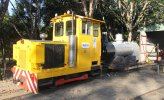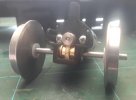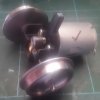OK - maybe some more red herrings, but firstly I only have a degree-equivalent professional qualification in a subject absolutely unrelated to what we're talking about here.
Probably the more relative experience is that I have played with trains for most of my 69 years, but only had electric trains since I was about 9 or 10.
I'm not in a position to challenge any of the scientific principles, it's just that I'm not sure that I can see them applying absolutely in our model world where so much of what we're talking about - electric motor, gears etc is, in scale terms, generally over engineered.
So, I'm probably repeating myself here, and being boring but:
- The original large brass worms are, in my simplistic mind, unlikely to generate enough of a flywheel motion to achieve any benefit - maybe a Bachmann failed experiment.
- The drive ratio at 35:1 shouldn't be too tall, but may be if the driving wheels are approaching 40 mm diameter. The 40:1 ratio with Greg's re-built gearbox should be better (purely in ratio terms)
- I don't think a two-stage gearbox (as re-worked by Bachmann) eases the load on the motor in any way - my understanding is that it relives stress on the gear train.
- A flywheel drive will be of little benefit when using battery power
All this still points me to the motor - but Rik has used a variety of motors, which is where it gets very puzzling.
Now, I could be shot down for this, but I seem to recall that using a mutli-pole motor i.e. a 5-pole or 7-pole will only deliver smoother starting a bit more bottom end grunt (very low) and doesn't deliver more power.
In some of Bachmann's other models, they use (I think Mabuchi motors) that have a low voltage draw, and are pretty lively (I'm thinking of the ones I have experience of such as the Mining Mogul, the Connie, and the 45 tonner) so, I'm still thinking that the answer could be with the motor.
Which leaves me pondering a bit, because as Greg found, someone had the same idea, and swapped a Buhler motor, which is normally considered to be quite powerful, although not always.
I still think the motor has got to be the answer, with a 40:1 gear ratio, and again based on experience and failure, a two stage gearbox would be preferable - but how that can be achieved ....................

When I had got through three gearbox / motor combinations on the Yeti, I installed one of these using the 33:1 ratio with 28mm diameter driving wheels.
Motor & Gearboxes — MSC Models
My 2-6-2 which uses 44mm driving wheels, has an ABC 50:1 gearbox, which makes it pretty slow and steady, and which hurts the bank balance a bit more




engineering.stackexchange.com



